According to the yoga tradition, there are three qualities, or three energetic forces, that are always present (to various degrees) in all things and beings in the world. Those qualities are the three gunas–rajas, tamas and sattva–and each of them has its own unique attributes. Those qualities are always present in our emotional states and in our interactions with the world. David Frawley describes the mental-emotional qualities of gunas as follows: “Sattva is the quality of light, love and life, the higher or spiritual force that allows us to evolve in consciousness. It imparts the dharmic virtues of faith, honesty, self-control, modesty and truthfulness. Rajas is the quality of twilight, passion and agitation, the immediate or vital force, which lacks stability or consistency. It gives rise to emotional fluctuations of attraction and repulsion, fear and desire, love and hate. Tamas is the quality of darkness, non-feeling and death, the lower or material force, which drags us down into the ignorance and attachment. It causes dullness, inertia, heaviness, emotional clinging and stagnation.”
The three gunas exist in dynamic interaction and influence each other in different ways. However, once one guna becomes dominant, it will remain dominant for some time. In the course of one day we can fluctuate between the states of rajas, tamas or sattva dominance in response to the sensations within our body and signals from the environment; then we might get stuck in a particular phase for a long period of time. For example, we might feel mildly irritated (rajas) and somewhat depleted (tamas) and then descend into a place of utter exhaustion (tamas). In yoga, we are focused on the development of sattva, the balancing and harmonizing force, which is essential for healing and spiritual advancement.
The Polyvagal Theory closely reflects the yogic idea of the three gunas and demonstrates how gunas show up in our autonomic nervous system. Our autonomic nervous system is a foundation upon which our entire lived experience is built. The Polyvagal Theory looks at the same three qualities through the lens of modern science and ties the interactions between states to the activities of the vagus nerve. It is a fascinating theory that is very useful for both understanding our own mental-emotional fluctuations and the psychological challenges that our students encounter.
Below is a list of articles that explore some foundational aspects of the Polyvagal Theory and describe different strategies for bringing ourselves to the state of balance.
Sequence Wiz blog posts on the Polyvagal Theory
Three main forces that regulate your homeostasis and inner balance
The Polyvagal Theory pioneered by Dr. Porges looks at the entire autonomic nervous system through the lens of our essential needs for safety and connection to other human beings. The Polyvagal Theory stipulates that instead of a dichotomy of “fight-and-flight” sympathetic activation that gets us going and “rest-and-digest” mode that slows us down, there are two kind of “brakes” we have built into our systems – a regular “foot brake”, and an “emergency brake”, and both of those brakes get activated by the vagus nerve under different conditions. Read more >
How your autonomic nervous system (ANS) defines your mental state, reactions and behavior
You can envision the activity of your ANS as a kind of ladder of physiological and resulting emotional states. You move up and down that ladder all day long. If all goes well, you climb up, mobilizing your resources as necessary to meet the challenges of the day. But if things start to spiral out of control, you might find yourself descending down first into frenetic activity and agitation, and then into numbness and exhaustion. According to the Polyvagal Theory, there are three main organizing principles that guide this daily activity. Read more >
How to deal with your daily ups and downs: The four R’s of restoring connection
From the perspective of the Polyvagal Theory, whenever we have a strong reaction to something, it is our autonomic nervous system trying to protect us from a perceived threat. We can sense it in ourselves and others as “being defensive”, and it can manifest as becoming withdrawn (dorsal vagal state) or openly combative (sympathetic state). What do we do about it? Read more >
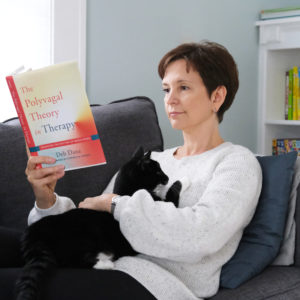 Short lessons from the Polyvagal Theory that can be useful to yoga teachers and yoga therapists
Short lessons from the Polyvagal Theory that can be useful to yoga teachers and yoga therapists
So much of our work as yoga teachers and yoga therapists goes beyond simply providing yoga instruction. It involves creating a safe space for our students, giving them our undivided attention, and promoting the kind of energetic exchange that uplifts and empowered them. I was reminded of those more subtle aspects of our work as I was reading The Polyvagal Theory in Therapy: Engaging the Rhythm of Regulation (Norton Series on Interpersonal Neurobiology) by Deb Dana. While the book is mostly geared toward mental health therapists, I believe that information presented in it about the psychology of the client – practitioner relationship is fundamental to what we do as yoga teachers. Here are some specific lessons for yoga teachers from the book that I thought were particularly valuable.
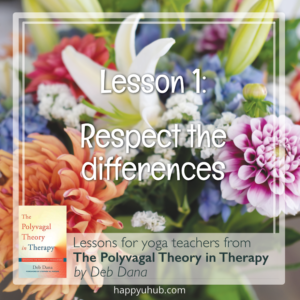
Lesson 1: Respect the differences
We need to remember that people’s reactions to our instructions and to the yogic tools we offer are highly individual. Sometimes we think we know which asanas, breath work and imagery should work, but they don’t. This is because our nervous system is shaped by our experiences. Deb Dana writes: “Autonomic patterns are built over time. The autonomic nervous system is shaped through experience. In response to experiences of connection and challenge, we develop a personal neural profile with habitual patterns of action.” This is why we can never Copy-Paste our practices from one person to another, from one class to another – there is so much variability in how our students respond to what we teach! That’s what makes it fun, too.
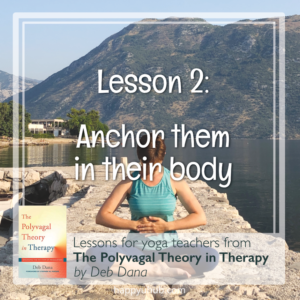
Lesson 2: Anchor them in their body
One of the quotes from the book that really resonated with me was “Our bodies know that they belong; it is our minds that make our lives so homeless” by John O’Donohue. One of the greatest gifts that we can give our students, most of whom spend their entire days in their heads, is to become more connected to and anchored in the wisdom of the body. That’s why we always ask our students for their feedback – how does this movement feel in your body? Where do you feel it? What exactly do you feel? This is a great practice for students to become more attuned to their actual experience.
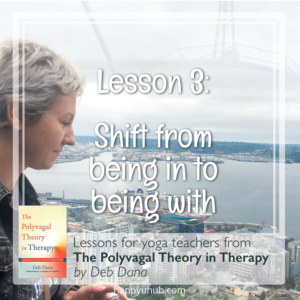
Lesson 3: Shift from being in to being with
When you are in the middle of a mental storm, it engulfs you. It becomes much harder to see past it and you might feel like you will never get out. I find that I feel the same way when I get a cold – a few days into it I usually feel like I will never get better, even though my experience tells me that at some point I will. It can be very difficult for ourselves and our students to step out of that state and look at it from the perspective of an observer – but this is what yoga is all about. It is about closely watching our mental fluctuations, which, once acknowledged, can then subside. Then we can have much more clarity about what’s going on.
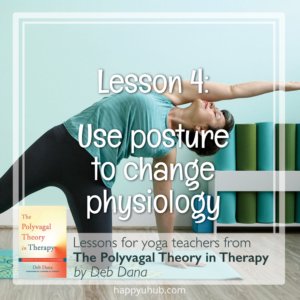
Lesson 4: Use posture to change physiology
The position of the body in relation to gravity has a major impact of the state of our autonomic nervous system. Deb Dana writes: “Baroreceptors, which are sensors located in blood vessels, respond quickly to changes in body position, increasing or decreasing heart rate via the action of the vagal brake. … Changing posture (including lying down, sitting, standing, turning, rocking, leaning) changes autonomic tone.” We can choose to use standing poses to give our students a bigger energetic boost, or bring them closer to the ground for a more calming effect, but every yoga practice (especially a private yoga session) needs to make sense not just from the perspective of anatomy (which muscles we work and how), but also from the perspective of physiology (how we impact the autonomic nervous system). Every practice needs to take the practitioner through the kind of ANS activation that is most appropriate for her current state and goals.
Lesson 5: Guide with your voice
Your voice is one of your most important therapeutic tools. Deb Dana writes: “Sound is one of the strongest triggers of a neuroception of safety. The ANS recognizes the features of prosody – the music of the voice. It is not the words themselves, but the patterns of rhythm and sound along with the frequency, duration, and intensity of speaking that reveals our intentions. The ANS, via neuroception, is listening beneath the words for sounds of safety and friendship.” Sometimes it might be tempting for yoga teachers to adopt a sing-song voice, but it is best to teach with your authentic voice, otherwise the ANS of your students will spot the fake and will not trust it.
Lesson 6: Encourage sangha-building
We need to encourage our students to build their own support system (sangha) for co-regulation. Seeking social support means cultivating positive relationships through work alliances, enduring friendships, intimate partnerships. As humans, we are wired to connect. Deb Dana writes: “When opportunities for connection are missing, we carry the distress in our nervous system. Our loneliness brings us pain.” We rely on other people to help us regulate our emotional states on the level of physiology. When two autonomic nervous systems begin co-regulating, “they form a feedback loop that creates an upward spiral of increasing vagal tone.”
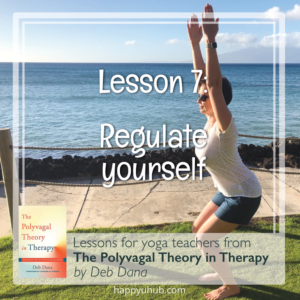
Lesson 7: Regulate yourself
As yoga teachers and yoga therapists, we have a responsibility to regulate our own autonomic states and bring a reliable flow of peaceful, social energy to every yoga class and session. Just like they advise in airplane safety videos: first put on your own oxygen mask, then assist others. Deb Dana writes: “An essential part of the therapy process is reaching out and offering cues of safety to clients.” This helps create a peaceful, safe, and productive therapeutic environment.
[jetpack_subscription_form]

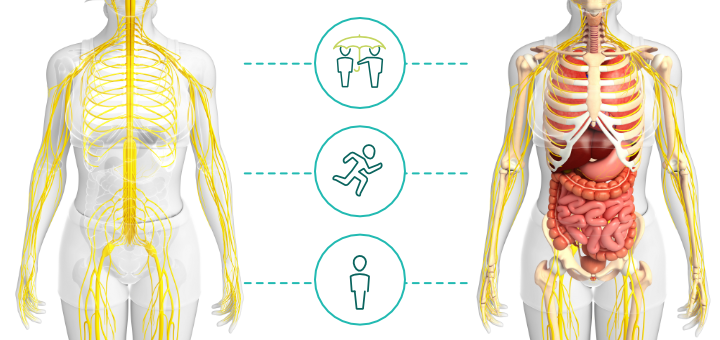


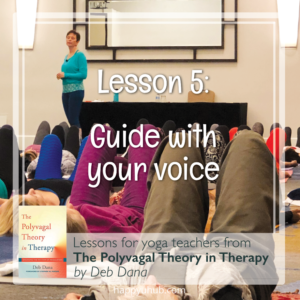
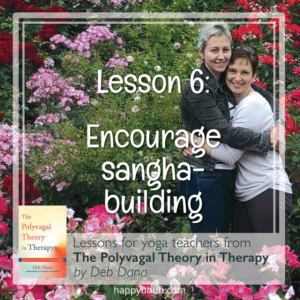
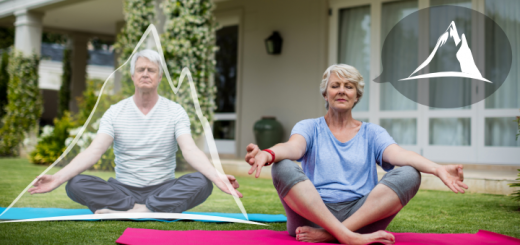
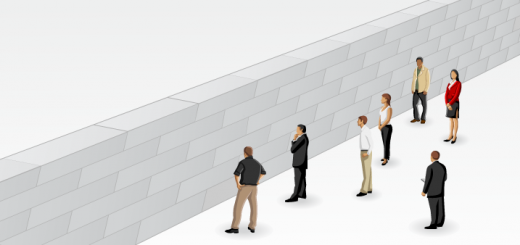
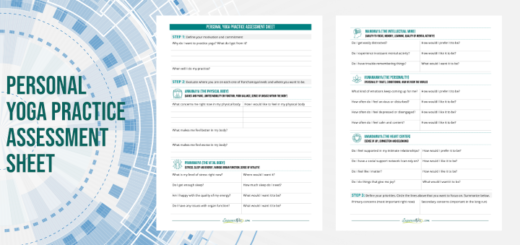
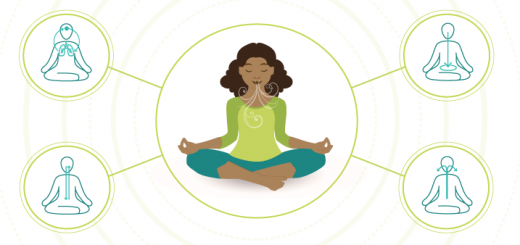
Olga you are amazing. Thank you